Search
- Page Path
-
- HOME
- Search
- Letter to the Editor
- Neonatology (Perinatology)
- Role of neutrophil CD11b expression in diagnosis of earlyonset neonatal sepsis in full-term infant
- Safaa ELMeneza, Walaa Mohamed, Iman Elbagoury, Karima Bahagat
- Clin Exp Pediatr. 2021;64(1):44-45. Published online April 14, 2020
-
Question: Can CD11b detect sepsis in full-term infants with suspected sepsis?
Finding: The percentage of neutrophils expressing CD11b was significantly upregulated in the sepsis and suspected sepsis groups versus the control group.
Meaning: CD11b is a sensitive marker for sepsis and suspected sepsis in full-term neonates and it may be added to sepsis markers. This information would allow the neonatologist to confidently discontinue antibiotic use as long as the neonate is clinically stable.
- Editorial
- Neurology
- Targeted temperature management and neuroprotective outcomes of pediatric patients after cardiac arrest
- Yun-Jin Lee
- Clin Exp Pediatr. 2020;63(5):180-181. Published online April 14, 2020
-
- Nephrology (Genitourinary)
- Dapsone: a steroid-sparing drug for refractory immunoglobulin A vasculitis?
- Jin-Soon Suh
- Clin Exp Pediatr. 2020;63(5):178-179. Published online April 14, 2020
-
- Allergy
- Trends in prevalence of allergic diseases in Korean children: how and why?
- Kyung Suk Lee
- Clin Exp Pediatr. 2020;63(7):263-264. Published online April 13, 2020
-
- Review Article
- Cardiology
- Pediatric heart transplantation: how to manage problems affecting long-term outcomes?
- Young Hwue Kim
- Clin Exp Pediatr. 2021;64(2):49-59. Published online April 8, 2020
-

Since the initial International Society of Heart Lung Transplantation registry was published in 1982, the number of pediatric heart transplantations has increased markedly, reaching a steady state of 500–550 transplantation annually and occupying up to 10% of total heart transplantations. Heart transplantation is considered an established therapeutic option for patients with end-stage heart disease. The long-term outcomes of pediatric heart...
- Perspective
- Pulmonology
- Early preemptive immunomodulators (corticosteroids) for severe pneumonia patients infected with SARS-CoV-2
- Kyung-Yil Lee, Jung-Woo Rhim, Jin-Han Kang
- Clin Exp Pediatr. 2020;63(4):117-118. Published online April 8, 2020
-
- Clinical Note
- Allergy
- Recurrent urticaria caused by specific cat serum albumin IgE cross-reacting with pork serum albumin
- Cheon Kim, Sung Won Kim, Yoon Ha Hwang
- Clin Exp Pediatr. 2020;63(11):451-453. Published online April 6, 2020
-
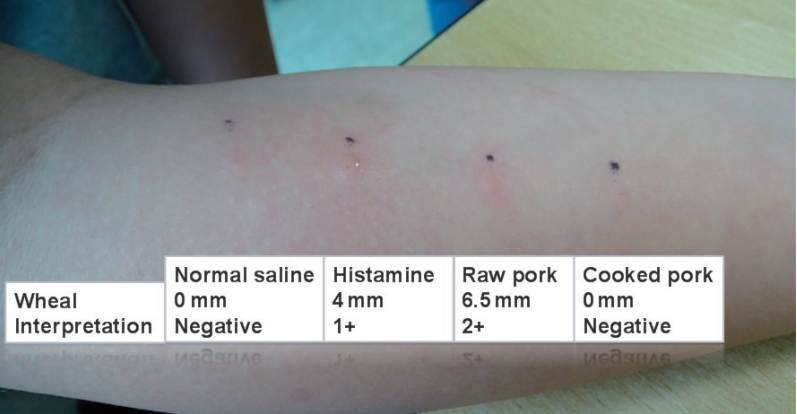
Question: What should be considered in children who complain of pork allergies?
Finding: History of raising a cat, the onset of symptoms after the ingestion of pork and specific IgE tests to pork, cat, milk, and Alpha-gal are needed.
Meaning: Pork cat syndrome could be the cause of pork allergies.
- Review Article
- Infection
- Epidemiology and clinical features of coronavirus disease 2019 in children
- Soo-Han Choi, Han Wool Kim, Ji-Man Kang, Dong Hyun Kim, Eun Young Cho
- Clin Exp Pediatr. 2020;63(4):125-132. Published online April 6, 2020
-
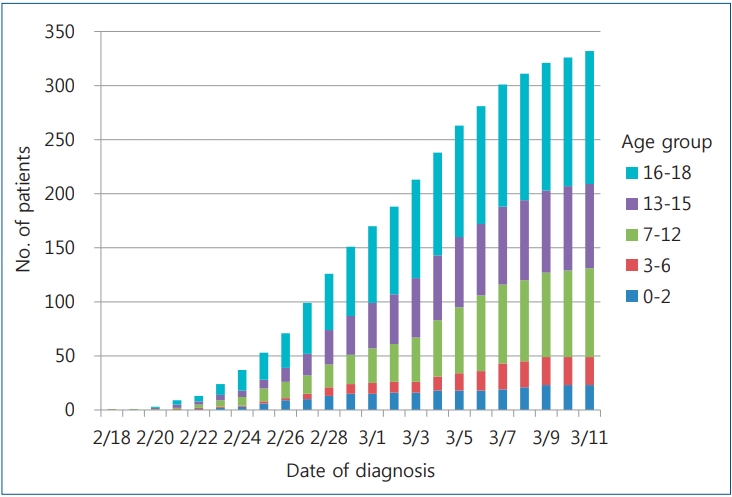
Coronavirus disease-2019 (COVID-19), which started in Wuhan, China, in December 2019 and declared a worldwide pandemic on March 11, 2020, is a novel infectious disease that causes respiratory illness and death. Pediatric COVID-19 accounts for a small percentage of patients and is often milder than that in adults; however, it can progress to severe disease in some cases. Even neonates...
- Epidemiology, virology, and clinical features of severe acute respiratory syndrome -coronavirus-2 (SARS-CoV-2; Coronavirus Disease-19)
- Su Eun Park
- Clin Exp Pediatr. 2020;63(4):119-124. Published online April 2, 2020
-

A cluster of severe pneumonia of unknown etiology in Wuhan City, Hubei province in China emerged in December 2019. A novel coronavirus named severe acute respiratory syndrome coronavirus-2 (SARS-CoV-2) was isolated from lower respiratory tract sample as the causative agent. The current outbreak of infections with SARS-CoV-2 is termed Coronavirus Disease 2019 (COVID-19) by the World Health Organization (WHO). COVID-19...
- Endocrinology
- Air pollution and childhood obesity
- Moon Young Seo, Shin-Hye Kim, Mi Jung Park
- Clin Exp Pediatr. 2020;63(10):382-388. Published online March 27, 2020
-

Questions: What are the possible effects of air pollution on the occurrence of childhood obesity and what are the mechanisms?
Finding: Epidemiologic studies suggest that air pollutants might act as obesogens in the pediatric population, and their possible mechanisms include oxidative stress, physical inactivity, and epigenetic modulation.
Meaning: This paper reviews updated information on air pollution, one of the modifiable environmental factors in childhood obesity.
- Original Article
- Neurobehavior
- Association between assisted reproductive technology and autism spectrum disorders in Iran: a case-control study
- Ensiyeh Jenabi, Mahdieh Seyedi, Ronak Hamzehei, Saeid Bashirian, Mohammad Rezaei, Katayoon Razjouyan, Salman Khazaei
- Clin Exp Pediatr. 2020;63(9):368-372. Published online March 27, 2020
-

Background: Autism spectrum disorder (ASD) is a neurodevelopmental disorder defined by impairments in social interaction and verbal and nonverbal communication.
Purpose: Determine the association between use of assisted reproduction technology (ART) and the risk of ASD among children. Methods: This case-control study included 300 participants (100 cases, 200 controls). The control group included women with a child aged 2–10 years without ASD,...
- Editorial
- Nephrology (Genitourinary)
- Undescended testis: importance of a timely referral to a surgical specialist
- Su Jin Kim
- Clin Exp Pediatr. 2020;63(11):429-430. Published online March 23, 2020
-
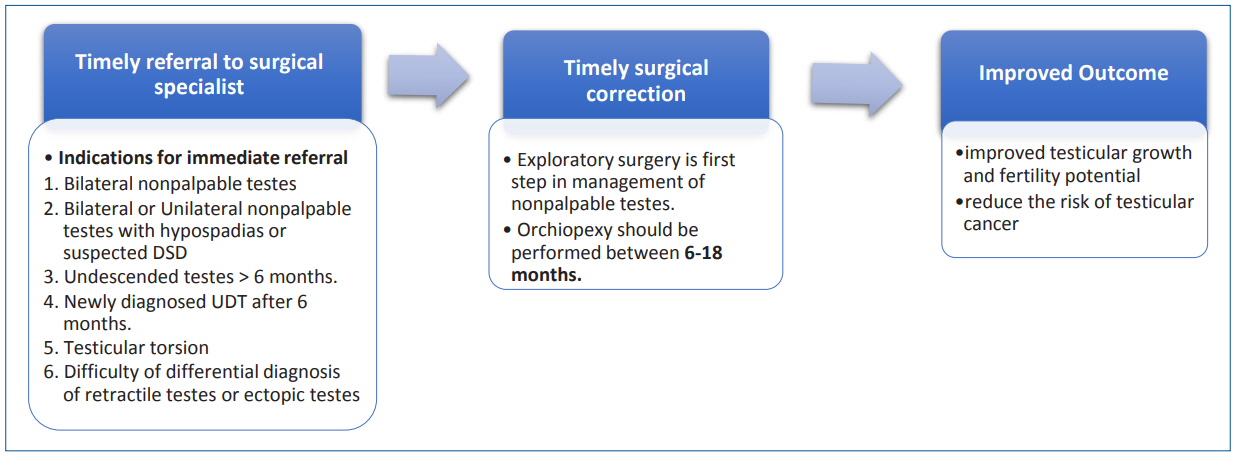
Undescended testes (UDT) is the most common congenital genitourinary abnormality in male infants and associated with decreased fertility and a higher future malignancy risk, especially in cases of delayed orchiopexy after puberty. It is important to timely referral to a surgical specialist and timely surgical correction of UDT to improve fertility and decrease the risk of malignancy.
- Review Article
- Other
- Comparison of diagnostic and treatment guidelines for undescended testis
- Jaeho Shin, Ga Won Jeon
- Clin Exp Pediatr. 2020;63(11):415-421. Published online March 23, 2020
-
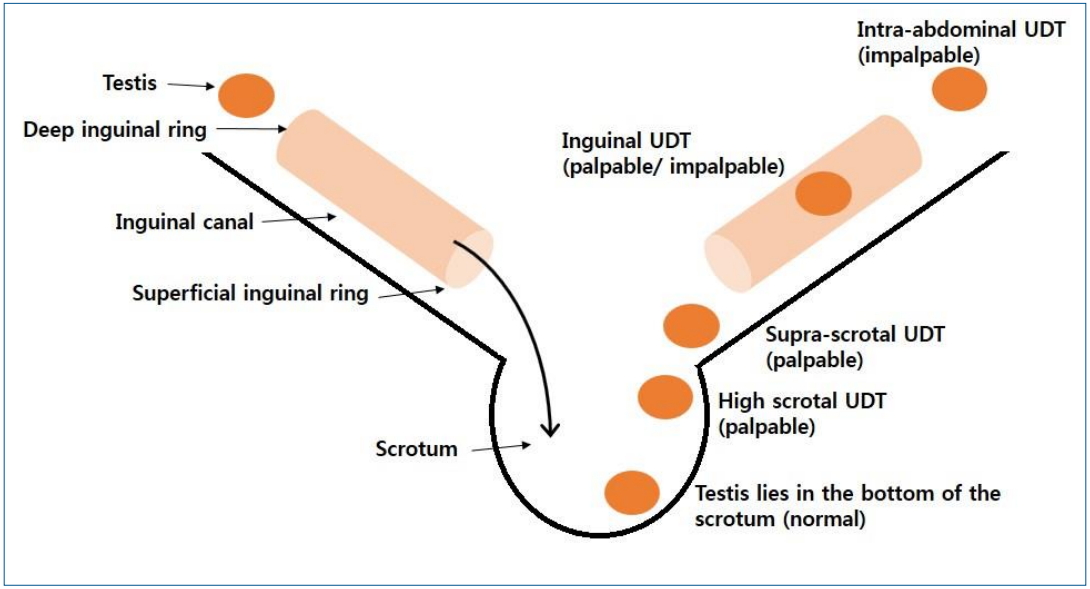
Primary caregivers should consider surgical specialist referral of patients with undescended testis if no descent occurs by 6 months, undescended testis is newly diagnosed after 6 months of age, or testicular torsion is suspected. Orchiopexy is recommended between 6 and 18 months at the latest. The original location of the testes and the age at orchiopexy are predictive factors for infertility and malignancy later in life.
- Nutrition
- Components of human breast milk: from macronutrient to microbiome and microRNA
- Su Yeong Kim, Dae Yong Yi
- Clin Exp Pediatr. 2020;63(8):301-309. Published online March 23, 2020
-
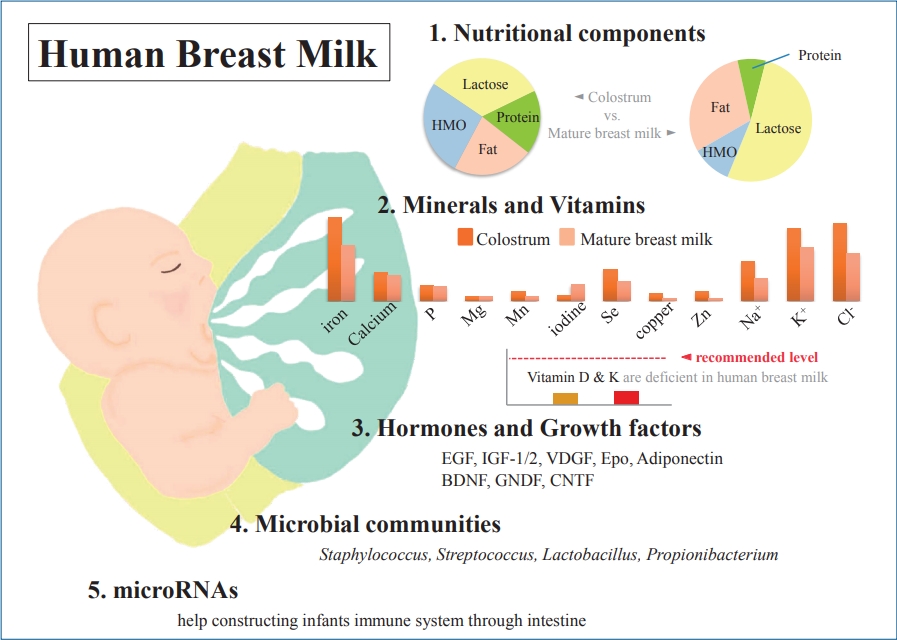
Human breast milk (HBM) is essential for the infant’s growth and development right after birth and is an irreplaceable source of nutrition for early human survival. Various infant formulas have many similarities to HBM in many components, but there is no perfect substitute for HBM. Recently, various breast milk components and their roles have been studied according to the development...
- Editorial
- Gastroenterology
- Management of perianal abscess and fistula-in-ano in infants and children
- Jinyoung Park
- Clin Exp Pediatr. 2020;63(7):261-262. Published online March 23, 2020
-
- Original Article
- Endocrinology
- Influence of subclinical hypothyroidism on metabolic parameters in obese children and adolescents
- Ozlem Kara
- Clin Exp Pediatr. 2020;63(3):110-114. Published online March 6, 2020
-

Question: Does subclinical hypothyroidism in obese children and adolescents affect metabolic parameters?
Finding: Insulin, HOMA-IR, and TG levels were higher and the HDL-C level was lower in patients with SH.
Meaning: A clear association is observed between SH, and insulin resistance and dyslipidemia in obese children. It can be said that the TSH may be evaluated as a metabolic risk factor in obese patients.
- Editorial
- Neurology
- Guideline for advanced neuroimaging in pediatric epilepsy
- Yun Jung Hur
- Clin Exp Pediatr. 2020;63(3):100-101. Published online March 6, 2020
-
- Letter to the Editor
- Neonatology (Perinatology)
- Risk factors for BiPAP failure as an initial management approach in moderate to late preterm infants with respiratory distress
- Heekwon Son, Eui Kyung Choi, Kyu Hee Park, Jeong Hee Shin, Byung Min Choi
- Clin Exp Pediatr. 2020;63(2):63-65. Published online February 15, 2020
-

Question: Which factors can predict BiPAP failure as the initial management approach for moderate to late preterm infants with respiratory distress?
Finding: RDS aggravation and increased oxygen and frequency requirements during BiPAP support were associated with BiPAP failure.
Meaning: Early changes to invasive ventilator care should be considered for moderate to late preterm infants showing RDS aggravation and increased oxygen and frequency requirements during BiPAP support.
- Editorial
- Pulmonology
- Are alternative antibiotics needed for antibiotic-nonresponsive Mycoplasma pneumoniae pneumonia?
- Eun-Ae Yang, Kyung-Yil Lee
- Clin Exp Pediatr. 2020;63(2):44-45. Published online February 15, 2020
-
- Review Article
- Neurology
- Advanced neuroimaging techniques for evaluating pediatric epilepsy
- Yun Jeong Lee
- Clin Exp Pediatr. 2020;63(3):88-95. Published online February 6, 2020
-

Accurate localization of the seizure onset zone is important for better seizure outcomes and preventing deficits following epilepsy surgery. Recent advances in neuroimaging techniques have increased our understanding of the underlying etiology and improved our ability to noninvasively identify the seizure onset zone. Using epilepsy-specific magnetic resonance imaging (MRI) protocols, structural MRI allows better detection of the seizure onset zone,...
- Hematology
- Genetic classification and confirmation of inherited platelet disorders: current status in Korea
- Ye Jee Shim
- Clin Exp Pediatr. 2020;63(3):79-87. Published online February 6, 2020
-

Inherited platelet disorders (IPDs), which manifest as primary hemostasis defects, often underlie abnormal bleeding and a family history of thrombocytopenia, bone marrow failure, hematologic malignancies, undefined mucocutaneous bleeding disorder, or congenital bony defects. Wide heterogeneity in IPD types with regard to the presence or absence of thrombocytopenia, platelet dysfunction, bone marrow failure, and dysmegakaryopoiesis is observed in patients. The individual...
- Original Article
- Neonatology (Perinatology)
- Effect of red blood cell transfusion on short-term outcomes in very low birth weight infants
- Eui Young Lee, Sung Shin Kim, Ga Young Park, Sun Hyang Lee
- Clin Exp Pediatr. 2020;63(2):56-62. Published online February 6, 2020
-
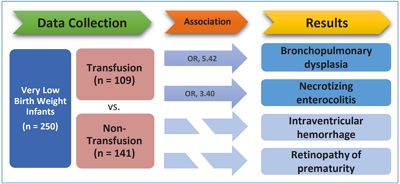
Question: Does RBC transfusion affect the short-term outcomes of VLBW infants?
Finding: The results showed that RBC transfusion was significantly related to the incidence of BPD (OR, 5.42; P<0.001) and NEC (OR, 3.40; P=0.009).
Meaning: Careful consideration of the patient’s clinical condition and appropriate guidelines is required before administering RBC transfusions.
- Editorial
- Gastroenterology
- Strategies for treating and managing chronic hepatitis C in children in the direct-acting antiviral era
- Suk-Jin Hong, Byung-Ho Choe
- Clin Exp Pediatr. 2020;63(2):46-47. Published online February 6, 2020
-

- Systematic review and meta-analysis
- Genetics and Metabolism
- Global prevalence of classic phenylketonuria based on Neonatal Screening Program Data: systematic review and meta-analysis
- Hamid Reza Shoraka, Ali Akbar Haghdoost, Mohammad Reza Baneshi, Zohre Bagherinezhad, Farzaneh Zolala
- Clin Exp Pediatr. 2020;63(2):34-43. Published online February 6, 2020
-
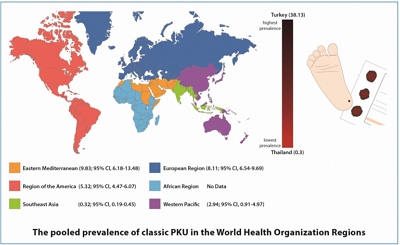
Question: What is the global prevalence of classic phenylketonuria based on Neonatal Screening Program Data?
Finding: The overall worldwide prevalence of the disease is 6.002 per 100,000 neonates. The highest prevalence (38.13) was reported in Turkey, while the lowest (0.3) in Thailand.
Meaning: This difference in the prevalence may be due to differences in the number of consanguineous marriages among the different regions, phenylalanine cutoff points, and sample sizes.
- Review Article
- General Pediatrics
- Association between maternal smoking during pregnancy and risk of bone fractures in offspring: a systematic review and meta-analysis
- Erfan Ayubi, Saeid Safiri, Kamyar Mansori
- Clin Exp Pediatr. 2021;64(3):96-102. Published online February 5, 2020
-

Question: What is the effect of maternal smoking during pregnancy (MSDP) on the risk of bone fractures in the offspring?
Finding: After the adjustment for misclassification, MSDP may be associated with a 27% increased risk of bone fracture in the offspring (pooled odds ratio, 1.27; 95% confidence interval, 1.00–1.62; I2=0%; P=0.537)
Meaning: Preventive measures and health education programs should be designed and implemented to encourage women to stop smoking, especially during.
- Allergy
- Montelukast use over the past 20 years: monitoring of its effects and safety issues
- Yong Ju Lee, Chang-Keun Kim
- Clin Exp Pediatr. 2020;63(10):376-381. Published online February 5, 2020
-
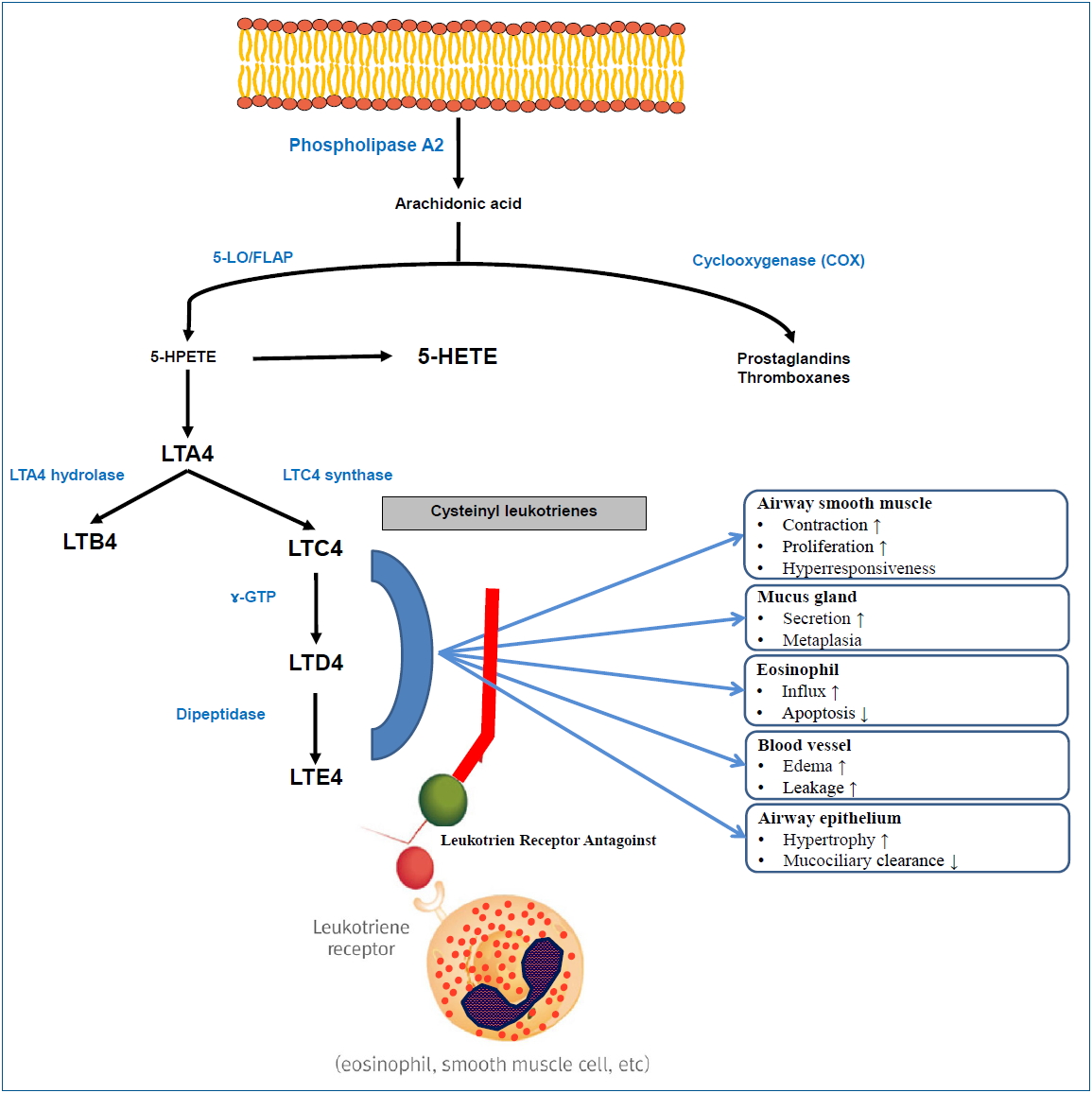
Although the efficacy of montelukast is inferior to that of ICS, both physicians and parents prefer montelukast to ICSs.
EDN may be a useful biomarker for the treatment and monitoring of preschool children with asthma.
The US FDA requires boxed warning about serious neuropsychiatric events of montelukast, therefore, physicians should consider the benefits and risks of montelukast before prescribing it.
- Neonatology (Perinatology)
- Short- and long-term outcomes of very low birth weight infants in Korea: Korean Neonatal Network update in 2019
- Jang Hoon Lee, YoungAh Youn, Yun Sil Chang; Korean Neonatal Network
- Clin Exp Pediatr. 2020;63(8):284-290. Published online February 5, 2020
-

The Korean Neonatal Network (KNN) has collected population-based data for very low birth weight infants (VLBWIs) born in Korea since 2013. The survival rate of all VLBWIs was 86% in Korea. The overall prevalence of cerebral palsy was 6.2%–6.6%. Bilateral blindness and hearing loss were reported in 0.2%–0.3%, 0.8%–1.9%, respectively. The KNN has published annual reports and papers for facilitating the improvement of VLBWIs outcome in Korea.
- Original Article
- General Pediatrics
- Ability of children to perform touchscreen gestures and follow prompting techniques when using mobile apps
- Savita Yadav, Pinaki Chakraborty, Arshia Kaul, Pooja, Bhavya Gupta, Anchal Garg
- Clin Exp Pediatr. 2020;63(6):232-236. Published online February 5, 2020
-

Background: Children today get access to smartphones at an early age. However, their ability to use mobile apps has not yet been studied in detail.
Purpose: This study aimed to assess the ability of children aged 2–8 years to perform touchscreen gestures and follow prompting techniques, i.e., ways apps provide instructions on how to use them. Methods: We developed one mobile app...
- Neonatology (Perinatology)
- Synbiotics use for preventing sepsis and necrotizing enterocolitis in very low birth weight neonates: a randomized controlled trial
- Ozge Serce Pehlevan, Derya Benzer, Tugba Gursoy, Guner Karatekin, Fahri Ovali
- Clin Exp Pediatr. 2020;63(6):226-231. Published online February 5, 2020
-
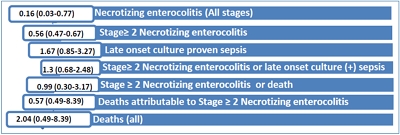
Background: Probiotics and prebiotics have strain-specific effects on the host. Synbiotics, a mixture of probiotics and prebiotics, are proposed to have more beneficial effects on the host than either agent has alone.
Purpose: We performed a randomized controlled trial to investigate the effect of Lactobacillus and Bifidobacterium together with oligosaccharides and lactoferrin on the development of necrotizing enterocolitis (NEC) or sepsis...
- Editorial
- Neonatology (Perinatology)
- What do we know about the long-term cognitive and behavioral outcomes of school-aged children who were born moderate to late preterm?
- Eun Sun Kim
- Clin Exp Pediatr. 2020;63(6):215-216. Published online February 5, 2020
-
-

-
-
8.02023CiteScore94th percentilePowered by
-
Impact Factor3.2
-
- TOPICS
- ARTICLE CATEGORY
- Editorial Office
-
Korean Pediatric Society
#1606 Seocho World Officetel, 19 Seoun-ro, Seocho-ku, Seoul 06732, Korea
Tel: +82-2-3473-7306 Fax: +82-2-3473-7307 E-mail: office@e-cep.org
Clinical and Experimental Pediatrics is an open access journal. All articles are distributed under the terms of the Creative Commons Attribution NonCommercial License (http://creativecommons.org/licenses/by-nc/4.0/)
Copyright © 2025 by Korean Pediatric Society.











